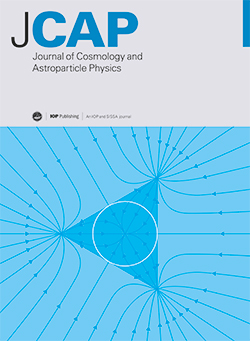The end of easy phenomenology for CMB experiments: A case study in the dark sector
IF 5.9
2区 物理与天体物理
Q1 ASTRONOMY & ASTROPHYSICS
Journal of Cosmology and Astroparticle Physics
Pub Date : 2025-05-27
DOI:10.1088/1475-7516/2025/05/094
引用次数: 0
Abstract
The precision of Cosmic Microwave Background (CMB) experiments, specifically its lensing reconstruction, has reached the limit where non-linear corrections cannot be ignored. Neglecting these corrections results in biased constraints on cosmological parameters. In this work, we use lensing data from Planck and the South Pole Telescope third generation camera (SPT-3G) taken in 2018 to highlight the impact of these biases in two ways. First, we estimate the shifts due to ignoring non-linear corrections in ΛCDM. We find 0.2–0.6σ shifts in the Dark Matter (DM) fraction, the Hubble constant, and the amplitude of matter fluctuations at 8h-1 Mpc. Second, we estimate the loss in constraining power for not including data sensitive to non-linear corrections. As a case study, we consider two interacting DM models, for which such corrections are not readily available in existing CMB Boltzmann codes. The first one is DM interacting with baryons, while the second is DM interacting with Dark Radiation (DR). For the former case, when we add primary CMB data from SPT-3G 2018 observations, we find that constraints on model parameters improve by 10–20% compared to previous studies. However, we forecast a further 50% improvement on these constraints if one could include current or upcoming SPT-3G lensing data. For the case of DM interacting with DR, no meaningful constraints on the model parameters are found without including information from CMB lensing. We also highlight that the codes used to calculate non-linear corrections in ΛCDM, specifically HaloFit andHMCode, provide unstable results when improperly used for these extended models. These outcomes constitute a reason for caution if using CMB lensing data when constraining such models, as well as a motivation for estimating their non-linear corrections.宇宙微波背景实验简单现象学的终结:黑暗领域的个案研究
宇宙微波背景(CMB)实验的精度,特别是它的透镜重建,已经达到了非线性修正不能忽略的极限。忽略这些修正会导致对宇宙学参数的有偏差约束。在这项工作中,我们使用2018年普朗克和南极望远镜第三代相机(SPT-3G)的透镜数据,从两方面强调这些偏差的影响。首先,我们估计由于忽略ΛCDM中的非线性修正而引起的移位。我们发现暗物质(DM)分数、哈勃常数和8h- 1mpc时物质波动的幅度发生了0.2-0.6σ的位移。其次,我们估计了不包括对非线性修正敏感的数据的约束能力损失。作为一个案例研究,我们考虑了两个相互作用的DM模型,对于这些模型,这种校正在现有的CMB玻尔兹曼码中不容易获得。第一种是DM与重子的相互作用,第二种是DM与暗辐射的相互作用。对于前一种情况,当我们添加来自SPT-3G 2018观测的原始CMB数据时,我们发现对模型参数的约束比以前的研究提高了10-20%。然而,我们预测,如果可以包括当前或即将到来的SPT-3G透镜数据,这些限制将进一步改善50%。对于DM与DR相互作用的情况,如果不包含来自CMB透镜的信息,则没有发现对模型参数有意义的约束。我们还强调,ΛCDM中用于计算非线性修正的代码,特别是HaloFit和hmcode,在不适当地用于这些扩展模型时,会提供不稳定的结果。这些结果构成了在约束此类模型时使用CMB透镜数据时要谨慎的理由,以及估计其非线性修正的动机。
本文章由计算机程序翻译,如有差异,请以英文原文为准。
求助全文
约1分钟内获得全文
求助全文
来源期刊

Journal of Cosmology and Astroparticle Physics
地学天文-天文与天体物理
CiteScore
10.20
自引率
23.40%
发文量
632
审稿时长
1 months
期刊介绍:
Journal of Cosmology and Astroparticle Physics (JCAP) encompasses theoretical, observational and experimental areas as well as computation and simulation. The journal covers the latest developments in the theory of all fundamental interactions and their cosmological implications (e.g. M-theory and cosmology, brane cosmology). JCAP''s coverage also includes topics such as formation, dynamics and clustering of galaxies, pre-galactic star formation, x-ray astronomy, radio astronomy, gravitational lensing, active galactic nuclei, intergalactic and interstellar matter.
 求助内容:
求助内容: 应助结果提醒方式:
应助结果提醒方式:


